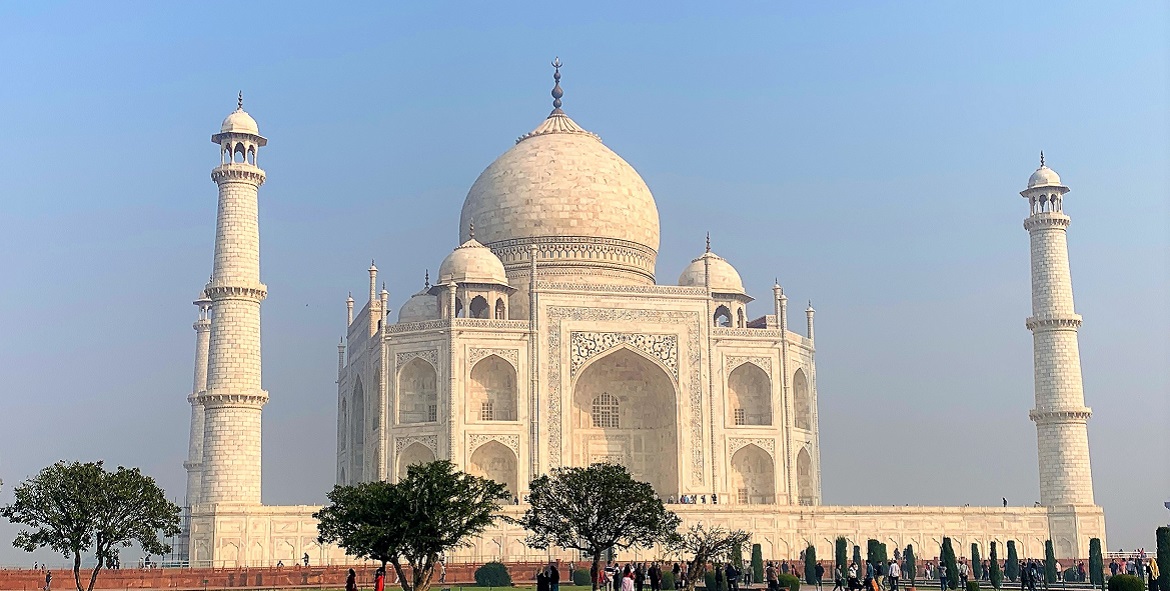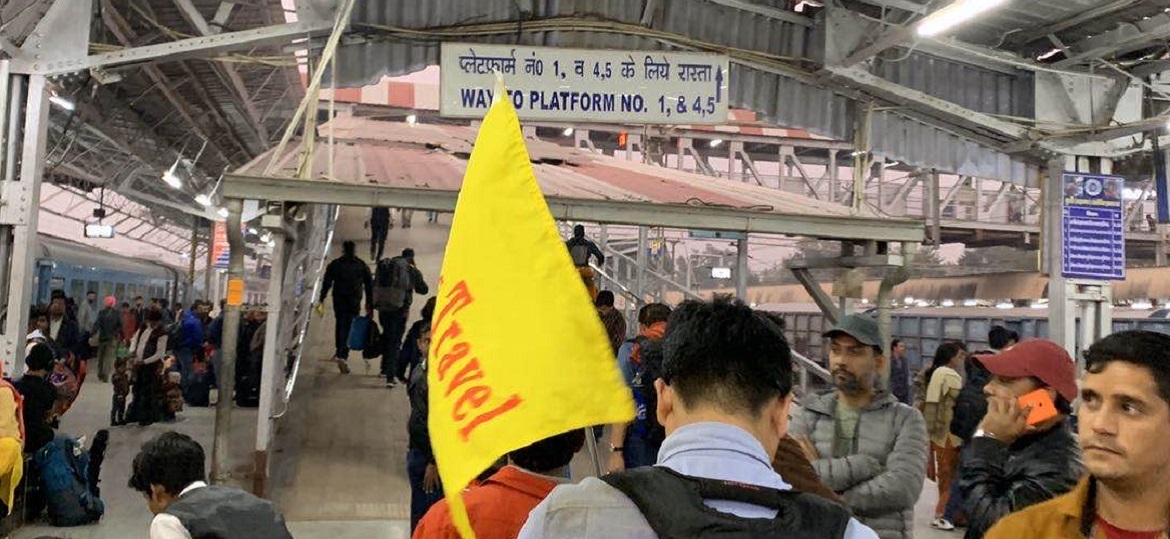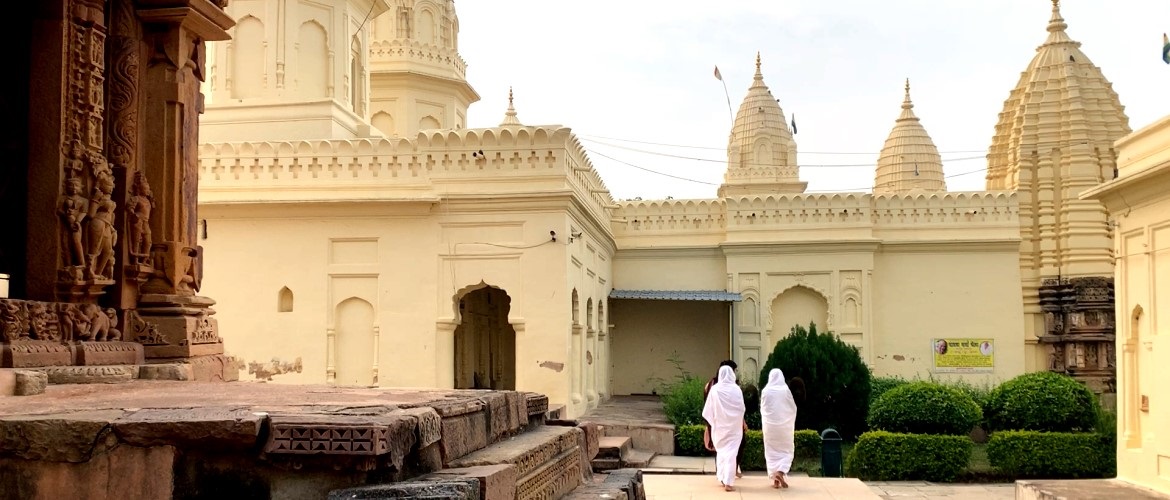If you are looking for India tours from Canada, you’ve just found the right company in Laurus Travel. We are a Canadian tour operator based in Canada having been around since 1998. Our primary focus is Asia with India being one of our key destinations. Whether you are a senior looking to go on an escorted group tour or a family with children needing a customized private family vacation package, we are here to help you make your dream come true. Our luxury group tours of India are ideal for seniors with just the right amount of walking required.

Our India tours from Canada emmphasize history, culture and fine good. Out of all our India tours from Canada, this 16-day Highlights of India is the most popular. The itinerary includes New Delhi, Varanasi, Khajuraho, Orchha, Agra, Fatehpur Sikri, Ranthambore National Park and Jaipur.
This luxury small-group tour is an excellent introduction for first-time visitors to India. Trip highlights include Taj Mahal (Agra), Amber Fort (Jaipur), evocative religious ceremonies (Varanasi), and wildlife sighting in Ranthambore National Park. An extravaganza of art, culture and history, this tour is packed with UNESCO World Heritage Sites.

Highlights of India Tour (16 days)
Luxury India tour on sale! Sign up today and save up to 10% on select departures.
Important Features
- Small group size
- Luxury accommodations
- Multilingual expert guides
- High-quality Indian & Western meals
- Inclusion of gratuities to local guides & drivers
- No annoying forced shopping
- Unlimited supply of bottled water during group activities
- Free Wi-Fi in all hotels
Meal Code: B = breakfast / L = lunch / D = dinner
Tour Itinerary
Day 01/Thu: Departing for New Delhi
The trip begins with your international flight for New Delhi from a city of your choice. You’ll lose a day upon crossing the International Date Line.
Day 02/Fri: Arrival in New Delhi
Meet your guide on arrival and transfer to the hotel in a private vehicle. No activity is scheduled for today and no meal is included.
Day 03/Sat: New Delhi (B/L/D)
Delhi is both a city and a national capital territory. The city of Delhi consists of two components – Old Delhi in the north and New Delhi in the south. Old Delhi is where most of the historical landmarks are located while New Delhi serves as the seat of India’s national government. Among the locals, Delhi and New Delhi are used interchangeably but this often leads to confusion among foreign visitors. Delhi is of great historical significance as an important commercial, transport, and cultural hub, as well as the political centre of India.
Our full-day sightseeing takes in Raj Ghat (Mahatma Gandhi Memorial), Jama Masjid (historic and largest mosque in India), Qutub Minar (minaret, UNESCO Heritage Site), and Humayun’s Tomb. Our schedule also includes a rickshaw ride in Chandni Chowk – a traditional market district of narrow streets crowded with shops selling all kinds of spices, dried fruits, jewelry, saris, etc.
Day 04/Sun: New Delhi – Varanasi (B/L/D)
The morning flight to Varanasi takes about an hour and half.
Located in the middle-Ganges valley, Varanasi is regarded as the spiritual capital by Hindus, a destination for pilgrimage, death and mourning. Varanasi is among the oldest continually inhabited cities in the world with a tradition heavily influenced by Islamic culture. The city’s population is currently estimated at around 1.2 million.
After lunch, we explore the archaeological site of Sarnath. Located 10 km northeast of Varanasi, Sarnath is the place where the Buddha gave his first sermon to his followers. The site contains ruins of Buddhist buildings, a 39-metre-high stupa, and the Sarnath Archaeological Museum which houses the famous Ashokan Lion Capital memorial pillar.
Witnessing prayer offering on the banks of the Ganges this evening is a major highlight of our trip. Performed by Hindu priests, this ritual begins at dusk every day and draws large crowds.
Day 05/Mon: Varanasi (B)
Enjoy an early morning boat ride on the Ganges. Observing the deceased lying in burning pyres next to devotees celebrating life in the holy river could be an emotional experience for many.
After a walking tour through parts of the ancient city, we spend the rest of the day at leisure.
Day 06/Tue: Varanasi – Khajuraho (B/L/D)
The morning flight to Khajuraho takes one hour.
Khajuraho is a small town with a population of no more than 25,000. However, it is one of the most popular tourist destinations in India owing to its large group of medieval Hindu and Jain temples, a UNESCO World Heritage Site collectively known as the Khajuraho Group of Monuments. Most of the temples were built between 885 AD and 1000 AD. Some of them are better known for their erotic sculptures although such sexual themes make up less than 10% of the entire temple sculptures.
We spend the afternoon exploring the main Hindu and Jain temples.
Evening entertainment is an outdoor sound and light show if available. The show attempts to present the basic history and myths of Khajuraho temples.
Day 07/Wed: Khajuraho – Orchha (B/L/D)
Our sightseeing in Khajuraho continues this morning.
After lunch we drive 200 km (3 hours) to Orchha.
Orchha is a sleepy little town nestled on the banks of the Betwa River. It was founded in 1531 by Rudra Pratap Singh, the first raja of the kingdom of Orchha, who also started the construction of the magnificent Orchha Fort complex. Once the power centre of Bundela Rajputs in the 16th century, the town seems to be frozen in time. Only through the grandeur of its old palaces and temples can the visitor sense its past glory.
Day 08/Thu: Orchha (B/L)
Our sightseeing in Orchha today consists of Raja Ram Temple, Jahangir Mahal, Chaturbhuj Temple, Laxmi Narayan Temple and the impressive Royal Cenotaphs.
Day 09/Fri: Orchha – Agra (B/L/D)
We transfer to the train station in Jhansi (20 km northwest of Orchha) following breakfast for our three-hour rail journey to Agra.
Situated by the Yamuna River and about 200 km southeast of Delhi, Agra is best known for Taj Mahal, a mausoleum complex built in the 17th century for Mumtaz Mahal, consort of Mughal emperor Shah Jahan. Agra has a long history preceding the arrival of the Mughals. However, the historical monuments we see today in Agra are almost exclusively associated with the Mughals who established an Islamic early-modern empire that controlled much of South Asia between the 16th and 19th centuries.
Afternoon sightseeing introduces us to the massive Agra Fort, also known as Red Fort, which was built between 1565 and 1573 for Akbar (1542-1605), the greatest of the Mughal emperors of India.
Day 10/Sat: Agra (B/L)
Our sightseeing today begins with a visit to the magnificent Taj Mahal early in the morning. Described as the most extravagant monument ever built for love, this poignant Mughal mausoleum has become the de facto emblem of India’s tourism. Commissioned in 1631 by the Mughal emperor Shah Jahan to house the tomb of his consort, Mumtaz Mahal, the ivory-white marble mausoleum has to be seen in person for its beauty to be truly felt.
Other attractions on our list to visit today include Emperor Akbar’s Tomb, and Itmad-Ud-Daulah’s Tomb (nicknamed Baby Taj, often regarded as a draft of the Taj Mahal).
Day 11/Sun: Agra – Ranthambore National Park (B/L/D)
After breakfast we travel overland to Ranthambore National Park (300 km). The entire journey including a stop at Fatehpur Sikri and lunch time takes about 7 hours.
Built during the second half of the 16th century by Emperor Akbar, Fatehpur Sikri (City of Victory) was capital of the Mughal Empire from 1571 to 1585. Inscribed as a UNESCO World Heritage Site in 1986, Fatehpur Sikri follows a uniform architectural style and includes one of the largest mosques in India.
Bound by Banas River to the north and Chambal River to the south, Ranthambore National Park covers an area of 1,334 square kilometres. It is named after the historic Ranthambore Fort, which lies within the park. The terrain interspersed with lakes and streams consists of tropical dry forest, open bushland and exposed rocks. The park is best known for its Bengal tigers which number to 86 according to the latest count in 2022. Besides tigers, wildlife in the national park includes the Indian leopard, Indian elephant, wild water buffalo, Indian bison, chinkara (Indian gazelle), and caracal, just to mention a few. In total, there are 40 mammal species living in the park. Visitors are also delighted by the large number of migratory and resident birds in the park; in fact, over 300 avian species have been recorded in and around the park.
Day 12/Mon: Ranthambore National Park (B)
Our morning and evening wildlife sighting safaris aboard purpose-designated vehicles are conducted by professionally trained naturalists. It is important to keep in mind that sighting of tigers is not guaranteed despite their relatively large number.
Day 13/Tue: Ranthambore National Park – Jaipur (B/L/D)
The 200 km drive to Jaipur following breakfast takes about 4 hours.
Jaipur is the capital of Rajasthan as well the state’s largest city with a current population of over 3 million. It is known as the Pink City due to the dominant colour scheme of its buildings. Jaipur was founded by the king of Amber, Maharaja Sawai Jai Singh II, for the purpose of being his new capital to replace the town of Amber. The move was necessitated due to lack of space and reliable water sources at Amber. Construction of Jaipur began in 1726 and took four years to complete. It was one of the earliest planned cities of modern India with a grid system interpreted in the light of Vedic architecture.
After lunch we visit a social enterprise engaged in the provision of vocational training to Jaipur’s street children. The goal of the nonprofit, non-governmental project is to equip the marginalized kids with valuable skills so that they can join mainstream society.
A visit to Birla Mandir follows dinner. This Hindu temple was built in 1988 and is constructed solely of white marble. It is dedicated to the Hindu goddess Lakshmi and Lord Vishnu (Narayan), whose images adorn the inside along with other Hindu gods and goddesses.
Day 14/Wed: Jaipur (B/L)
We begin today’s sightseeing at Amber Fort, a sprawling palace complex originally built by Raja Man Singh (r. 1589-1614) and expanded by Jai Singh I (r. 1621-1667). Improvements and additions were done by successive rulers over the next 150 years until Jaipur became the capital in 1727. Amber Fort is constructed of red sandstone and white marble. The opulent palace is laid out on four levels, each with a courtyard, and serves as a great example of Rajput architecture.
We spend the rest of the day exploring the City Palace, Hawa Mahal (Palace of the Winds), and Jantar Mantar (astronomical observatory built in the 17th century).
Those wishing to check out a night market can go with the guide following dinner.
Day 15/Thu: Jaipur – New Delhi (B/L)
The drive back to Delhi (300 km) plus lunch time could take up to 6 hours. After hotel check-in, guests interested in shopping will have a vehicle with driver at their disposal.
Day 16/Fri: Departing for Home (B)
The memorable India tour comes to an end this morning. The local guide will escort you to the airport in a private vehicle at a time suitable for your flight.
Check out departure dates, hotel list and current prices or contact us for a customized tour of India from Canada.

India Travel Q&A
Do I need a passport to visit India?
Yes. Your passport must have at least 2 blank visa pages and 6 months of validity at the end of the tour.
Do I need a tourist visa to enter India?
Yes, visa is required. India issues electronic visa to eligible applicants. Details can be found on Indian government’s website. India tourist e-Visa for Canadians and Americans, valid for 30 days to 1 year or 5 years, currently cost US$25, US$40 and US$80 respectively. Payment can be made by Visa or MasterCard. Please note that a card payment surcharge of 2.5% applies to all transactions in addition to any applicable foreign transaction and/or currency conversion costs. If you go on an India tour with Laurus Travel, we will assist you with the application.
What immunizations do I need for India?
Visitors may be asked for proof of vaccinations against COVID-19 prior to or on arrival. Nucleic acid or PCR testing prior to arrival is no longer required. Where applicable, updated information on this will be provided to the guest when their balance of payment is due (90 days prior to departure).
We are not aware of any other inoculation requirements and we suggest that you visit the websites of your national government’s disease control centre and the Indian High Commission or embassy in your country for the latest. We recommend all of our guests to be vaccinated against hepatitis A.
What should I watch out for to stay heathy while in India?
Do not drink from the tap. Ask for bottled or boiled water when eating in restaurants. When buying bottled water from street vendors, especially at tourist sites, make sure the cap is properly sealed because some vendors may be selling tap water in recycled bottles.
Try to avoid uncooked food. Raw food, even clean, may cause stomach upset or diarrhoea.
Always carry a roll of toilet paper and a bottle of hand sanitizer containing more than 60% of alcohol, no matter where you go.
Always have an N95 type of facemask handy when you travel by public transport. Passengers sitting next to you may be sick and cough loud but wear nothing to cover their mouth.
Banknotes in general carry all kinds of germs. Minimize your contact with local banknotes and coins by keeping them in a plastic bag and sanitize your hands every time you touch them. Use plastic for payment as much as possible.
How do I pay for local purchases?
The Indian currency known as rupee (ISO code: INR) can be withdrawn from ATMs upon arrival in India. Please keep your inventory of local currency to the minimum. The tour fare already covers all the expensive items and most, if not all, of the meals. You only need some local cash, which can be easily obtained as you go, for such incidentals as souvenirs and tips not included in the tour price.
Consider using credit cards for transactions over $20. Visa and MasterCard are widely accepted across India. Street vendors may ask for U.S. dollars but please exercise caution if you want to play along.
Do you offer travel insurance?
Yes, the insurance plans we offer cover a wide range of risks including medical emergencies and losses due to trip cancellation. Please contact us for premium quotes when you are ready to sign up with us.
Are there any direct flights to India from Canada?
Yes, Air Canada and Air India offer non-stop flights between Toronto and New Delhi. From Vancouver, non-stop flight to New Delhi is available via Air India. Both airlines use Boeing 777. If you find the flights too long (13 to 15+ hours), you have break up the long journey with a stopover in Europe or East Asia depending on the airport you choose to fly out of. For those who want to fly premium economy or business class, we have unbeatable deals available all year round.
Why makes Laurus Travel’s India tours particularly senior-friendly?
We have taken many concrete measures to make our India tours enjoyable for seniors. These include considerate pacing, frequent washroom breaks, avoiding activities requiring hard physical excretion, small group size, comfortable accommodations, clear communication about tour details, inclusion of leisure or downtime, so on and so forth.
One thing we pay particular attention to is customer feedback. We continuously gather feedback from seniors who join our India tours and use that information to improve future offerings. Only through such conscientious efforts can we make India tours for seniors truly successful.

